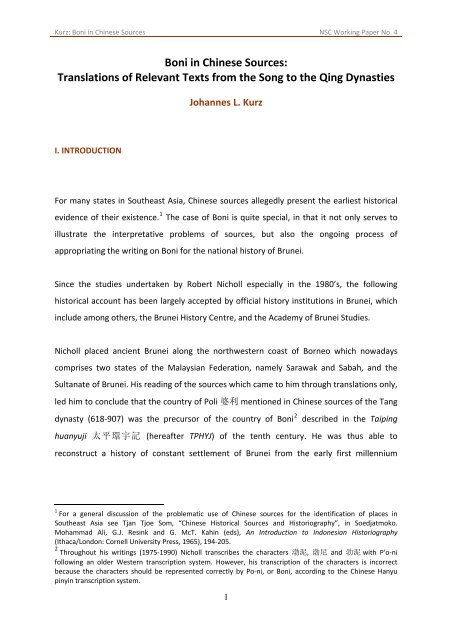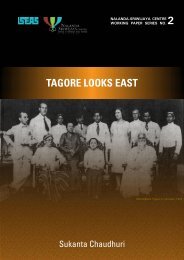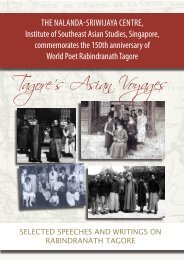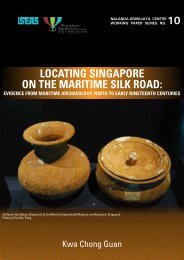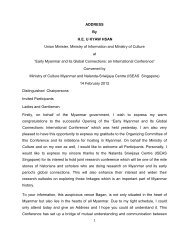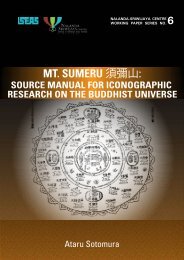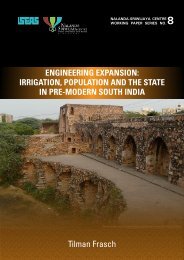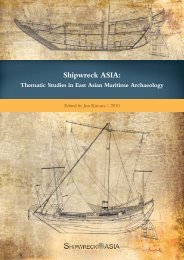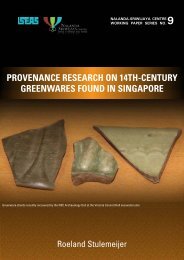Boni in Chinese Sources - Nalanda-Sriwijaya Centre - iseas
Boni in Chinese Sources - Nalanda-Sriwijaya Centre - iseas
Boni in Chinese Sources - Nalanda-Sriwijaya Centre - iseas
You also want an ePaper? Increase the reach of your titles
YUMPU automatically turns print PDFs into web optimized ePapers that Google loves.
Kurz: <strong>Boni</strong> <strong>in</strong> Ch<strong>in</strong>ese <strong>Sources</strong> NSC Work<strong>in</strong>g Paper No. 4<strong>Boni</strong> <strong>in</strong> Ch<strong>in</strong>ese <strong>Sources</strong>:Translations of Relevant Texts from the Song to the Q<strong>in</strong>g DynastiesJohannes L. KurzI. INTRODUCTIONFor many states <strong>in</strong> Southeast Asia, Ch<strong>in</strong>ese sources allegedly present the earliest historicalevidence of their existence. 1 The case of <strong>Boni</strong> is quite special, <strong>in</strong> that it not only serves toillustrate the <strong>in</strong>terpretative problems of sources, but also the ongo<strong>in</strong>g process ofappropriat<strong>in</strong>g the writ<strong>in</strong>g on <strong>Boni</strong> for the national history of Brunei.S<strong>in</strong>ce the studies undertaken by Robert Nicholl especially <strong>in</strong> the 1980’s, the follow<strong>in</strong>ghistorical account has been largely accepted by official history <strong>in</strong>stitutions <strong>in</strong> Brunei, which<strong>in</strong>clude among others, the Brunei History <strong>Centre</strong>, and the Academy of Brunei Studies.Nicholl placed ancient Brunei along the northwestern coast of Borneo which nowadayscomprises two states of the Malaysian Federation, namely Sarawak and Sabah, and theSultanate of Brunei. His read<strong>in</strong>g of the sources which came to him through translations only,led him to conclude that the country of Poli 婆 利 mentioned <strong>in</strong> Ch<strong>in</strong>ese sources of the Tangdynasty (618‐907) was the precursor of the country of <strong>Boni</strong> 2 described <strong>in</strong> the Taip<strong>in</strong>ghuanyuji 太 平 環 宇 記 (hereafter TPHYJ) of the tenth century. He was thus able toreconstruct a history of constant settlement of Brunei from the early first millennium1 For a general discussion of the problematic use of Ch<strong>in</strong>ese sources for the identification of places <strong>in</strong>Southeast Asia see Tjan Tjoe Som, “Ch<strong>in</strong>ese Historical <strong>Sources</strong> and Historiography”, <strong>in</strong> Soedjatmoko.Mohammad Ali, G.J. Res<strong>in</strong>k and G. McT. Kah<strong>in</strong> (eds), An Introduction to Indonesian Historiography(Ithaca/London: Cornell University Press, 1965), 194‐205.2 Throughout his writ<strong>in</strong>gs (1975‐1990) Nicholl transcribes the characters 渤 泥 , 渤 尼 and 勃 泥 with P'o‐nifollow<strong>in</strong>g an older Western transcription system. However, his transcription of the characters is <strong>in</strong>correctbecause the characters should be represented correctly by Po‐ni, or <strong>Boni</strong>, accord<strong>in</strong>g to the Ch<strong>in</strong>ese Hanyup<strong>in</strong>y<strong>in</strong> transcription system.1


